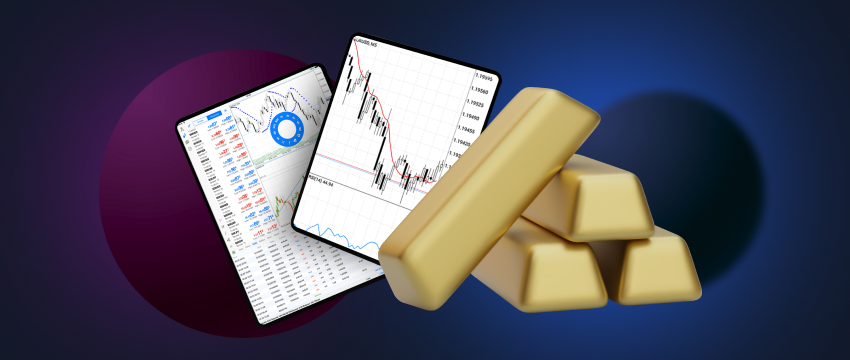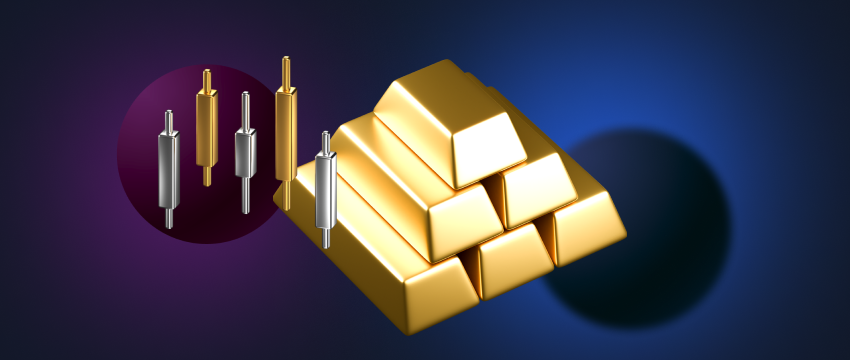In the context of metals trading is a group of commodities which are often used to diversify a trader’s portfolio. Their value is typically based on their rarity and industrial usage but regardless of how valuable a metal is, it does come with inherent risk. Some of the most popular metals are silver, gold, platinum, copper, palladium, and aluminium.
Categories and prices of metals
Metals are typically grouped into two categories, precious metals (e.g., gold, silver, platinum) and industrial metals (e.g., copper, aluminium, zinc, and steel). The price of these metals is influenced by several different factors. This includes scarcity or demand for them, what they are used for, geopolitical uncertainties (especially in the region in which the metal is mined), global economic news, and general market or investor sentiment. This makes metals (commodities) trading incredibly volatile.

CFD trading metals in financial markets
Contracts for Difference (CFDs) are derivative instruments used to trade metals, without the trader having to own the underlying asset. Instead, the trader speculates on the prices of the metals rising or falling. A trader will then either go long (buy) if they believe the price will rise or go short (sell) if they expect the price to fall. CFDs are highly leveraged which means a trader is only required to invest a fraction of the value of the trade.
The world’s most sought-after metals
Let’s talk about some of the most popular metals among global traders and investors.
Gold
Gold is probably one of the world’s most widely traded metals. Its popularity is largely due to its value as a form of currency and its use in jewellery. Gold prices are normally set daily and implemented via gold futures or spot gold. Gold futures enable traders to buy or sell an amount of gold on a future date through a standardised contract. In contrast, spot gold refers to a transaction in which gold is traded on the spot, not sometime in the future.
What causes gold prices to fluctuate?
Gold prices are influenced by the rise and fall of interest rates. In other words, if interest rates go up, gold prices tend to fall. Prices are also impacted by the supply and demand for the commodity, i.e., if the want for the metal rises (for industrial usage, in jewellery, as currency, etc), then gold prices typically increase as well. The rising cost of gold mining also impacts gold prices.
Silver
Silver is another popular commodity, perhaps even more than gold, causing silver prices to fluctuate pretty frequently. Silver is traded in a variety of ways, as follows:
- Via CFDs whereby traders speculate on the prices of silver without owning the metal.
- On commodity exchanges in the form of futures and options contracts.
- Through Exchange Traded Funds (EFTs), the EFTs hold silver as their underlying assets.
- As stocks in silver mining companies.
- The purchase of silver in its physical form.

Why opt for CFD silver trading?
There are many reasons a trader will choose CFD silver trading. For one, CFDs are highly leveraged. This means the trader can manage larger positions with less capital, increasing trading opportunities. CFDs also don’t require the trader to own the physical asset. This eliminates the need for insurance or safe storage which come at an additional cost. CFDs typically require a smaller capital investment so even a trader with a smaller budget can enter the trading space.
Silver is a highly liquid commodity. CFDs allow you to take advantage of this liquidity by giving you the flexibility to enter and exit positions quickly. CFDs also give a trader the ability to profit off rising and falling silver prices. In other words, you can go short if you foresee the market heading for a dip.
Platinum
The demand for platinum is not only as a precious metal, but also as an industrial metal. In its raw form, this commodity is used not only in jewellery production but also in the manufacture of products across multiple industries, including automotive, petroleum and computer. Platinum is sometimes used by investors as a hedge against inflation and as a potential store of wealth during times of economic uncertainty. The commodity is also sometimes used for portfolio diversification as a way to spread potential risk.

How are platinum prices impacted?
While platinum is typically priced higher than gold (per ounce), it is an incredibly volatile metal. This is because supply and demand of this commodity is largely impacted by trade disputes, sanctions, or conflicts in the regions in which it is mined. 90% of the world’s platinum is mined in South Africa, with the rest split between the US, Zimbabwe, Canada, and Russia.
Palladium
Palladium has become increasingly more appealing to global traders, particularly due to the increase in demand for this metal. Mostly mined in South Africa and Russia, palladium is extracted in much the same way as platinum and nickel. The metal is used primarily for producing catalytic converters for automobiles. It is however also used for plating in different electronic products. CFDs are a popular way for trading on palladium. Other ways of investing in palladium include buying or selling it at its spot price or via a futures contract.
So, why trade metals?
While not without risk, commodities trading offers traders diversification of one’s portfolio, a hedge against inflation, high liquidity levels, and more. But, taking into account the level of risk inherent in trading metals, a strategic risk management plan is key to mitigate unexpected losses. What does this mean in practice though? Well, let’s jump in:
- Educate yourself. Learn everything that you can about trading commodities. Access industry related podcasts, webinars, videos, blogs, and any other resources that will widen your scope of knowledge.
- Define your trading goals. Ensure you properly define what objectives you are trying to achieve through metals trading. Only by working towards something specific will you be more focused.
- Establish your trading style. This is critical. It requires properly assessing your psychology, the level of risk you’re willing to take on and the budget you have available. Once you’ve ascertained these three components, you can then pick a trading style that aligns best.
- Stick to a trading plan. Another important part of your metals trading journey is being consistent. Create a plan and follow that plan. Impulsive trading typically leads to adverse trading outcomes. Instead, establish the rules by which you will trade in your trading plan and don’t deviate unless absolutely necessary. There will obviously be moments that an adjustment will be required but for the most part, stick to your plan as best you can.
Most importantly, remember that all trading involves high risk. If you don’t remain vigilant, the possibility of incurring massive losses increases significantly. Take whatever measures necessary to safeguard your funds as best you can.
Disclaimer: This material is for general informational & educational purposes only and should not be considered investment advice or an investment recommendation. T4Trade is not responsible for any data provided by third parties referenced or hyperlinked, in this communication.



